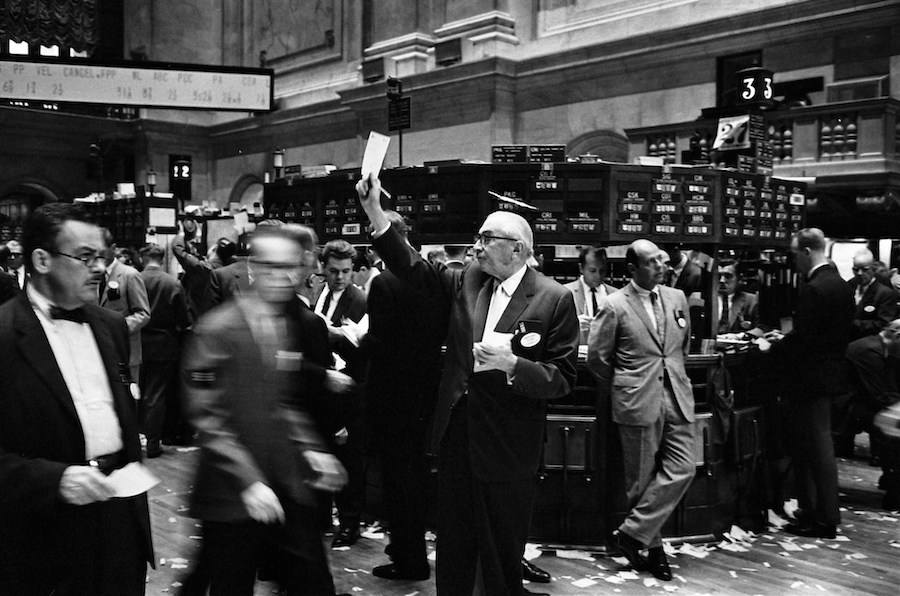In his classic book Risk, Uncertainty, and Profit, Frank Knight introduced a distinction between measurable uncertainty, which he called “risk,” and “true uncertainty,” which cannot “by any method be reduced to an objective, quantitatively determined probability” (Knight, 1921, p. 321). Knight argued that “true uncertainty” arises from change that cannot be fully foreseen with probabilistic rules.
Why is recognizing the relevance of unforeseeable change important for understanding aggregate outcomes, such as stock returns? As the last few weeks made palpable, events such as the Coronavirus pandemic and the oil dispute between Saudi Arabia and Russia can lead to changes in the process driving stock returns. The timing and magnitude of such change could not have been foreseen ex ante, even in probabilistic terms.
But unforeseeable change does not stem only from large-scale events; if it did, Knightian uncertainty would become relevant only occasionally; most of the time, market participants would face standard probabilistic risk. Beyond the impact of occasional large-scale events, the return process undergoes very frequent small changes stemming from myriad events that are at least in part unique and thus cannot be foreseen ex ante with a probabilistic rule. For example, such shifts could stem from company-level developments, including a new management team, changes in the production or service processes, the launch of new products or firms, and mergers. Developments in the broader economy could also affect the structure underpinning companies’ prospects, and thus stock returns, from shifts in fiscal and monetary policy to regulatory reform and trade deals.[1]
The consequences of such change for market outcomes, and thus payoffs from market participants’ decisions, cannot be fully comprehended – even in hindsight. For Knight, recognizing such unforeseeable change is the key to understanding profit-seeking behavior in real-world markets.
That is not true for contemporary macroeconomists and finance theorists. For nearly a half-century, the professional consensus has held that economists can account for market outcomes with models that exclude Knightian uncertainty. Although they differ in a number of important respects, both of the defining approaches that have emerged since the 1970s – the Rational Expectations Hypothesis (REH) and behavioral finance – rest on a common core premise: unforeseeable change is unimportant for understanding market outcomes. Indeed, both approaches represent all changes in the process underpinning outcomes with mechanical (probabilistic) rules, such as Markov switching.[2]
What, one might ask, is this premise doing in behavioral-finance models? After all, the insight that underpins these models is that psychological factors, such as market sentiment, play an important role in driving outcomes. One would expect psychological factors to influence outcomes at times and in ways that cannot be represented ex ante with fixed, mechanical rules. And yet, because they rule out Knightian uncertainty, behavioral economists rely on models that do precisely that: represent market sentiment with probabilistic rules over an indefinite future.[3]
Examining the role of market sentiment thus offers a way to assess the empirical relevance of consensus models’ premise that Knightian uncertainty is unimportant for understanding outcomes. Our paper “How Market Sentiment Drives Forecasts of Stock Returns,” provides empirical evidence that, contrary to this premise, changes in market sentiment drive unforeseeable change in how stock returns unfold over time, thereby engendering Knightian uncertainty.
Our Findings: Market Sentiment and Unforeseeable Change
We uncover a novel channel through which market participants’ sentiment influences how they forecast stock returns: their optimism (pessimism) affects the weights they assign to fundamentals. Our analysis yields four main findings. First, if good (bad) “news” about dividends and interest rates coincides with participants’ optimism (pessimism), the news about these fundamentals has a significant effect on participants’ forecasts of future returns and has the expected signs (positive for dividends and negative for interest rates). Second, in models without interactions, or when market sentiment is neutral or conflicts with news about dividends and/or interest rates, this news often does not have a significant effect on ex ante or ex post returns. Third, market sentiment is largely unrelated to the state of economic activity, indicating that it is driven by non-fundamental considerations. Moreover, market sentiment influences stock returns highly irregularly, in terms of both timing and magnitude.
Our finding that market sentiment influences how participants forecast returns is inconsistent with models that rely on the rational expectations hypothesis to represent these forecasts. A key feature of any REH model of stock returns is that it relates participants’ forecasts of returns solely to fundamentals.
Our findings lend support to the insight that motivated the behavioral-finance approach: non-fundamental factors, such as market sentiment, exert a significant influence on participants’ forecasts and thus on returns. However, our findings appear strongly inconsistent with the behavioral-finance models’ formalizations of the role of market sentiment, which rule out unforeseeable change and the Knightian uncertainty that such change engenders.
Behavioral-finance models’ representations of structural change assume that market sentiment influences participants’ forecasts of stock returns at times and in ways that can be specified with a probabilistic rule. The results from our analysis of such change, however, suggest that the relationship among stock returns, fundamentals, and sentiment is highly erratic. The erratic timing and magnitude of structural change arising from market sentiment, which we report in the paper, seem difficult to approximate with probabilistic rules on the basis of historical data, let alone represent ex ante over an indefinite future.[4]
It seems plausible that market sentiment proxies for a broad array of factors that characterize how participants interpret the state of the economy at any point in time and forecast how this state might change over time. But, because some of these factors are, at least in part, non-repetitive, there are no past data that could have characterized ex ante their effects on the change in economic outcomes – and thus stock returns – with a probabilistic rule.[5] This interpretation of structural change in how market sentiment influences stock returns is consistent with a number of earlier studies that related change in the process driving stock returns to historical events that are at least in part unique.[6]
A Way Forward
The findings of this paper point toward a way forward to a synthesis of milestone approaches that have been developed since 1970s. Frydman et al. (2019) show that by recognizing the relevance of Knightian uncertainty, macroeconomic and finance models can account for the role of both the fundamental factors on which REH models focus and the psychological factors underpinning behavioral-finance models. Opening a model to unforeseeable change implies that there are myriad possible forecasts. Thus, in making decisions – for example, about how many stocks to buy or sell – market participants face inherent ambiguity. They select particular forecasts by relying on a combination of considerations, including formal (econometric) models, market sentiment, and other non-fundamental factors.
References
Ang Andrew and Allan Timmermann (2012), “Regime Changes and Financial Markets,” Annual Review of Financial Economics, 4, 313-327.
Barberis, Nicolas C., Shleifer, Andrei, Robert Vishny (1998), “A Model of Investor Sentiment,” Journal of Financial Economics, 49, 307-343.
Frydman, Roman, Goldberg Michael D. and Nicholas J. Mangee (2015), “Knightian Uncertainty and Stock-Price Movements: Why the REH Present-Value Model Failed Empirically,” Economics, 9, 1-50.
Frydman, Roman, Johansen, Søren, Rahbek, Anders and Morten Nyboe Tabor (2019), “The Knightian Uncertainty Hypothesis: Unforeseeable Change and Muth’s Consistency Constraint in Modeling Aggregate Outcomes,” INET Working Paper, March.
Frydman, Roman, Mangee, Nicolas and Josh R. Stillwagon (2020), “How Market Sentiment Drives Forecasts of Stock Returns,” INET Working Paper, May 2020.
Hamilton, James D. (1988), “Rational-Expectations Econometric Analysis of Changes in Regime: An Investigation of the Term Structure of Interest Rates,” Journal of Economics Dynamics and Control, 385-423.
Hamilton, James D. (2008), “Regime-switching Models,” In Durlauf, Steven and Lawrence Blume (eds.), New Palgrave Dictionary of Economics, 2nd edition, Palgrave McMillan Ltd
Knight, Frank H. (1921), Risk, Uncertainty and Profit, Boston: Houghton Mifflin.
Stillwagon, Josh R. and Peter Sullivan (2020), “Markov Switching in Exchange Rate Models: Will More Regimes Help?,” Empirical Economics, forthcoming.
Stillwagon, Josh R. and Peter Sullivan (2020), “Markov Switching in Exchange Rate Models: Will More Regimes Help?,” Empirical Economics, forthcoming.
[1] Frydman et al. (2015) provide descriptive evidence that 20% of events that triggered movements in US stock prices between 1993 and 2009 were, at least in part, non-repetitive.
[2] For a seminal development of models relying on Markov switching to represent change in the process driving aggregate outcomes, and in how market participants forecast these outcomes, see Hamilton (1988, 2008).
[3] Both REH and behavioral-finance models typically use so-called Markov switching rules to represent change in outcomes. For a seminal example of the model of market sentiment relying on such a rule, see Barberis et al. (1998).
[4] Stillwagon and Sullivan (2020) find that while a Markov switching model approximates the exchange-rate process within sample, it is difficult to ascertain the number of observed states required for such an approximation, particularly out of sample. Moreover, Stillwagon and Sullivan demonstrate that the Markov switching model involving the best-performing number of regimes ex post, which gives the model a very favorable bias, could not outperform a random walk out of sample.
[5] David Hendry has pioneered econometric studies focusing on the inherent difficulties in modeling structural change with probabilistic rules. In a series of papers and books, he has demonstrated not only that macroeconomic models experience structural breaks, but also that these breaks are often triggered by historical events. See Hendry and Doornik (2014), Hendry (2018), and references therein.
[6] For econometric evidence, see Ang and Timmermann (2012) and references therein.








